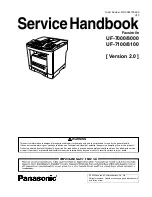
9
q
w e
e
w
q
q
w
q
w
e
w
e
q
Removing and Attaching the Foot Holder
Changing the Presser Foot
• Removing the foot holder
Raise the needle to its highest position by turning
the
handwheel counterclockwise. Raise the presser
foot, and remove the thumbscrew
q
by turning it
counterclockwise with a screwdriver.
• Attaching the foot holder
Align the hole in the foot holder
w
with the threaded
hole in the presser bar
e
. Fit the thumbscrew
q
into the hole. Tighten the thumbscrew
q
by turning it
clockwise with a screwdriver.
q
Thumbscrew
w
Foot holder
e
Presser bar
CAUTION:
Turn OFF the power switch before changing the foot.
Always use the proper foot for the selected pattern.
The wrong foot can cause the needle to break.
• Removing the presser foot
Raise the needle to its highest position by turning the
handwheel counterclockwise. Raise the presser foot,
and press the lever
q
on the back of the foot holder.
• Attaching the presser foot
Place the selected presser foot so that the pin
e
on
the foot lies just under the groove
w
in the foot holder.
Lower the presser bar to lock the foot into the place.
q
Lever
w
Groove
e
Pin
CAUTION:
Turn OFF the power switch before removing or
attaching foot holder.
Presser Foot Lifter
The presser foot lifter
q
raises and lowers the presser
foot.
You can raise the foot about 0.6 cm higher than the
normal up position
w
for easy removal of the presser
foot, or to help you place thick material under the foot.
q
Presser foot lifter
w
Normal up position
e
Highest position
Presser Foot Pressure Dial
The presser foot pressure dial should be set at “6” for
regular sewing.
Set the pressure between “3” and “6” for applique,
cutwork, drawn work, basting and embroidery.
Set the pressure between “1” and “3” when sewing
chiffon, lace, organdy and other fine fabrics.
Velour and knits with a lot of stretch may also require a “1”
setting.
Turn the presser foot pressure dial
q
and set the desired
number.
q
Presser foot pressure dial














































